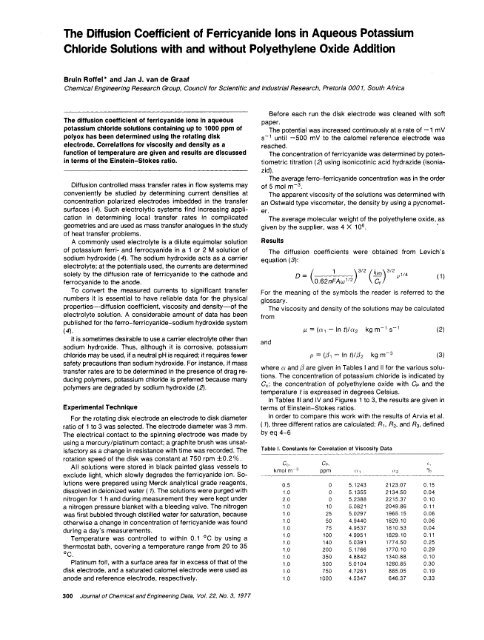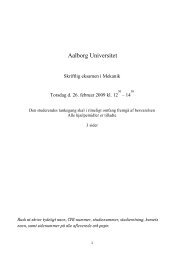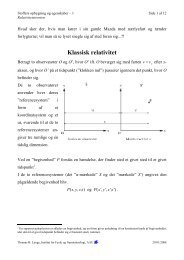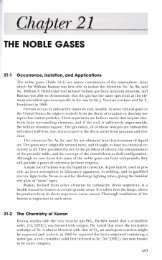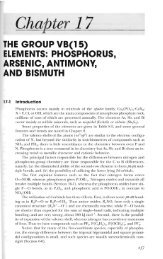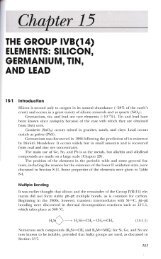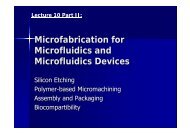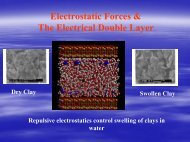The Diffusion Coefficient of Ferricyanide Ions in Aqueous Potassium ...
The Diffusion Coefficient of Ferricyanide Ions in Aqueous Potassium ...
The Diffusion Coefficient of Ferricyanide Ions in Aqueous Potassium ...
You also want an ePaper? Increase the reach of your titles
YUMPU automatically turns print PDFs into web optimized ePapers that Google loves.
<strong>The</strong> <strong>Diffusion</strong> <strong>Coefficient</strong> <strong>of</strong> <strong>Ferricyanide</strong> <strong>Ions</strong> <strong>in</strong> <strong>Aqueous</strong> <strong>Potassium</strong>Chloride Solutions with and without Polyethylene Oxide AdditionBru<strong>in</strong> R<strong>of</strong>fel" and Jan J. van de GraafChemica! Eng<strong>in</strong>eer<strong>in</strong>g Research Group, Council for Scientific and Industrial Research, Pretoria 000 1, South Africa<strong>The</strong> diffusion coefficient <strong>of</strong> ferricyanide ions <strong>in</strong> aqueouspotassium chloride solutions conta<strong>in</strong><strong>in</strong>g up to 1000 ppm <strong>of</strong>polyox has been determ<strong>in</strong>ed us<strong>in</strong>g the rotat<strong>in</strong>g diskelectrode. Correlations for viscosity and density as afunction <strong>of</strong> temperature are given and results are discussed<strong>in</strong> terms <strong>of</strong> the E<strong>in</strong>ste<strong>in</strong>-Stokes ratio.<strong>Diffusion</strong> controlled mass transfer rates <strong>in</strong> flow systems mayconveniently be studied by determ<strong>in</strong><strong>in</strong>g current densities atconcentration polarized electrodes imbedded <strong>in</strong> the transfersurfaces (4). Such electrolytic systems f<strong>in</strong>d <strong>in</strong>creas<strong>in</strong>g application<strong>in</strong> determ<strong>in</strong><strong>in</strong>g local transfer rates <strong>in</strong> complicatedgeometries and are used as mass transfer analogues <strong>in</strong> the study<strong>of</strong> heat transfer problems.A commonly used electrolyte is a dilute equimolar solution<strong>of</strong> potassium ferri- and ferrocyanide <strong>in</strong> a 1 or 2 M solution <strong>of</strong>sodium hydroxide (4). <strong>The</strong> sodium hydroxide acts as a carrierelectrolyte; at the potentials used, the currents are determ<strong>in</strong>edsolely by the diffusion rate <strong>of</strong> ferricyanide to the cathode andferrocyanide to the anode.To convert the measured currents to significant transfernumbers it is essential to have reliable data for the physicalproperties-diffusion coefficient, viscosity and density-<strong>of</strong> theelectrolyte solution. A considerable amount <strong>of</strong> data has beenpublished for the ferro-ferricyanide-sodium hydroxide system(4).It is sometimes desirable to use a carrier electrolyte other thansodium hydroxide. Thus, although it is corrosive, potassiumchloride may be used, if a neutral pH is required; it requires fewersafety precautions than sodium hydroxide. For <strong>in</strong>stance, if masstransfer rates are to be determ<strong>in</strong>ed <strong>in</strong> the presence <strong>of</strong> drag reduc<strong>in</strong>gpolymers, potassium chloride is preferred because manypolymers are degraded by sodium hydroxide (2).Experimental TechniqueFor the rotat<strong>in</strong>g disk electrode an electrode to disk diameterratio <strong>of</strong> 1 to 3 was selected. <strong>The</strong> electrode diameter was 3 mm.<strong>The</strong> electrical contact to the sp<strong>in</strong>n<strong>in</strong>g electrode was made byus<strong>in</strong>g a mercury/plat<strong>in</strong>um contact: a graphite brush was unsatisfactoryas a change <strong>in</strong> resistance with time was recorded. <strong>The</strong>rotation speed <strong>of</strong> the disk was constant at 750 rpm f0.2%.All solutions were stored <strong>in</strong> black pa<strong>in</strong>ted glass vessels toexclude light, which slowly degrades the ferricyanide ion. Solutionswere prepared us<strong>in</strong>g Merck analytical grade reagents,dissolved <strong>in</strong> deionized water ( 7). <strong>The</strong> solutions were purged withnitrogen for 1 h and dur<strong>in</strong>g measurement they were kept undera nitrogen pressure blanket with a bleed<strong>in</strong>g valve. <strong>The</strong> nitrogenwas first bubbled through distilled water for saturation, becauseotherwise a change <strong>in</strong> concentration <strong>of</strong> ferricyanide was founddur<strong>in</strong>g a day's measurements.Temperature was controlled to with<strong>in</strong> 0.1 OC by us<strong>in</strong>g athermostat bath, cover<strong>in</strong>g a temperature range from 20 to 35OC.Plat<strong>in</strong>um foil, with a surface area far <strong>in</strong> excess <strong>of</strong> that <strong>of</strong> thedisk electrode, and a saturated calomel electrode were used asanode and reference electrode, respectively.Before each run the disk electrode was cleaned with s<strong>of</strong>tpaper.<strong>The</strong> potential was <strong>in</strong>creased cont<strong>in</strong>uously at a rate <strong>of</strong> - 1 mVs-' until -500 mV to the calomel reference electrode wasreached.<strong>The</strong> concentration <strong>of</strong> ferricyanide was determ<strong>in</strong>ed by potentiometrictitration (2) us<strong>in</strong>g isonicot<strong>in</strong>ic acid hydrazide (isoniazid).<strong>The</strong> average ferro-ferricyanide concentration was <strong>in</strong> the order<strong>of</strong> 5 mol m-3.<strong>The</strong> apparent viscosity <strong>of</strong> the solutions was determ<strong>in</strong>ed withan Ostwald type viscometer, the density by us<strong>in</strong>g a pycnometer.<strong>The</strong> average molecular weight <strong>of</strong> the polyethylene oxide, asgiven by the supplier, was 4 X lo6.Results<strong>The</strong> diffusion coefficients were obta<strong>in</strong>ed from Levich'sequation (3):For the mean<strong>in</strong>g <strong>of</strong> the symbols the reader is referred to theglossary.<strong>The</strong> viscosity and density <strong>of</strong> the solutions may be calculatedfromand@ = (CY, - In t)/n2 kg m-ls-l (2)p = ($, - In t)/& kg m-3 (3)where N and 0 are given <strong>in</strong> Tables I and II for the various solutions.<strong>The</strong> concentration <strong>of</strong> potassium chloride is <strong>in</strong>dicated byC,; the concentration <strong>of</strong> polyethylene oxide with Cp and thetemperature t is expressed <strong>in</strong> degrees Celsius.In Tables 111 and IV and Figures 1 to 3, the results are given <strong>in</strong>terms <strong>of</strong> E<strong>in</strong>ste<strong>in</strong>-Stokes ratios.In order to compare this work with the results <strong>of</strong> Arvia et al.( I), three different ratios are calculated: R1, R2, and R3, def<strong>in</strong>edby eq 4-6Table 1. Constants for Correlation <strong>of</strong> Viscosity Data0.51 .o2.01 .o1 .o1.01 .o1 .o1.01 .o1.01 .o1 .o1 .o0001025507510014020035050075010005.12435.13555.23885.08215.02974.94404.95374.99515.03915.17664.88425.01044.72614.53472123.072134.502215.372049.861965.151829.101810.531829.101774.501770.101340.881280.85885.05646.370.150.040.100.110.060.060.040.110.250.290.100.300.190.33300 Journal <strong>of</strong> Chemical and Eng<strong>in</strong>eer<strong>in</strong>g Data, Vd. 22, No. 3, 7977
Table II. Constants for Correlation <strong>of</strong> Density Datacc 1 e,kmol m-3 dl 32 YO05 117 483 0 1049 010 02 $210 122 648 0 114320 138 279 0 1321 0 01&p= 30Table 111. <strong>The</strong> Dp/ T Ratio for Various Solutions and Temperatures <strong>in</strong>the Range from 20 to 35 OCc, cp, ioi5 R ~ , 1015 R~ 1015 R~ 1kmol m-3 ppm kg m s-* K-’ kg m sC2 K-’ kg m s - K-’ ~-ftI5200 PPM140PpMLP TO IOOPPM05 0 2 29610 0 2 259J28 3620 0 2 256‘ernperoture “C10 10 2 187 2 156 2 16310 25 2 290 2 228 2 241 Figure 1. E<strong>in</strong>ste<strong>in</strong>-Stokes ratio as a function <strong>of</strong> temperature1.0 50 2.220 2.092 2.1171 .o 75 2.345 2.174 2.2071.0 100 2.262 2.072 2.1061.0 140 2.456 2.086 2.1161.0 200 2.700 2.087 2.1931.0 350 2.955 1.994 2.158although we would prefer the use <strong>of</strong> R, only.Arvia et al. ( I) relate the different ratios to the average radius<strong>of</strong> a solvodynamic unit.<strong>The</strong> viscosity pels stands for the real viscosity <strong>of</strong> the solutionwith polymer; the viscosity pc stands for the viscosity <strong>of</strong> the samesolution without polymer.<strong>The</strong> diffusion coefficient D, is calculated from eq 1 by us<strong>in</strong>gthe k<strong>in</strong>ematic viscosity and current for the solution with polymer;the diffusion coefficient D,, however, is calculated by us<strong>in</strong>g thek<strong>in</strong>ematic viscosity for the solution without polymer and thecurrent for the same solution with polymer.For polymer solutions up to 350 ppm the E<strong>in</strong>ste<strong>in</strong>-Stokesratios R1, RP, and R3 are constant over the whole temperaturerange from 20 to 35 OC, as can be seen from Table 111.From Table IV it can be seen that at higher polymer concen-10 100 1000ppm po0ror -Figure 2. E<strong>in</strong>ste<strong>in</strong>-Stokes ratio as a function <strong>of</strong> the polyethylene oxideconcentration.trations these ratios are temperature dependent.In Figure 1, R, is given as a function <strong>of</strong> temperature for differentpolymer concentrations.<strong>The</strong> dependence <strong>of</strong> R on the polymer concentration can beseen from Table 111 and Figures 2 and 3.Up to 100 ppm the ratio R1 is <strong>in</strong>dependent <strong>of</strong> the polyoxTable IV. <strong>The</strong> Dp/T Ratio for High Concentrated Polyox Solutions, at a <strong>Potassium</strong> Chloride Concentration <strong>of</strong> 1.0 kmol m-3Cf. CP . T, 1, 10” D,. 10” D, 10’5 R’, 1015 R2, 10’’ R3.mol m-3 ppm OC PA m2 s-’ m2 s-l kg m s - ~ K-’ kg m s - ~ K-’ kg m s-’ K-’4.69 500 20.8 1244.69 500 23.7 1324.69 500 24.4 1334.69 500 26.6 1404.69 500 28.0 1434.69 500 31.2 1524.69 500 33.8 1604.69 750 18.6 1114.69 750 21.0 1164.69 750 24.8 1234.69 750 26.8 1264.69 750 29.5 1314.69 750 35.0 1414.56 1000 17.0 1004.56 1000 199 1044.56 1000 23.4 1104.56 1000 27.0 1144.56 1000 30.4 1204.56 1000 35.0 1246.5187.0477.0907.5817.7648.3478.8755.9276.2236.6236.7787.0647.6275.6345.8336.1766.3416.6806.7865.8306.3046.3546.7846.9537.5048.0095.0055.2745.6425.7915.5386.5964.5074.6985.0135.1935.5165.6743.4203.4243.3923.4313.3873.3353.3004.1404.0223.8073.6733.5333.2755.1154.7574.4544.0513.8163.3381.9541.9621.9461.9691.9511.9591.9791.7791.7571.7081.6711.6431.5851.67716111.5711.4921.4661.3642 1852 1952 1711968195119592 1902 1062 0732 0051956191618332 0962 0001935182116121632Journal <strong>of</strong> Chemical and Eng<strong>in</strong>eer<strong>in</strong>g Data, Vol. 22, No. 3, 1977301
10 I00 1000ppm POIYOXFigure 3. E<strong>in</strong>ste<strong>in</strong>-Stokes ratio for different polyox solutionsconcentration; the ratios R2 and R3 are <strong>in</strong>dependent up to 350ppm. <strong>The</strong> results can be summarized by: for 20 < t < 35 OC, Cp5 100 ppm:DsFslT = (2.27 f 0.09)10-15 kg m sT2 K-'for 20 < t < 35 OC, Cp < 350 pprn:andDcyclT = (2.1 1 f 0.12)10-i5 kg m s-* K-lD,p,l T = (2.16 f 0.08)10-15 kg s - ~ K-'c(7)For higher polymer concentrations the E<strong>in</strong>ste<strong>in</strong>-Stokes ratiobecomes temperature and concentration dependent, and mustbe obta<strong>in</strong>ed from the results presented <strong>in</strong> the tables and figures.Discussion<strong>The</strong> value <strong>of</strong> the E<strong>in</strong>ste<strong>in</strong>-Stokes ratio for aqueous potassiumchloride solutions without polymer addition is, accord<strong>in</strong>g to TableIll, found to be (2.28 f 0.08)10-15 kg m s - ~ K-'. Arvia et al. ( 7)found <strong>in</strong> this case a value <strong>of</strong> (2.00 f 0.12)10-15 kg m K-l,hence a difference <strong>of</strong> about 14%. One explanation for this differencemay be the fact that Arvia et al. used an electrode to diskdiameter ratio <strong>of</strong> about 1 to 1.15, although a ratio <strong>of</strong> at least 1to 2.4 is recommended (4). In our study we used a 1 to 3 ratio.For the diffusion coefficient <strong>in</strong> carboxymethyl cellulose solutionsArvia et al. found that the value <strong>of</strong> R3 was constant for the wholerange <strong>of</strong> polymer solutions between 0.2 and 1.6% CMC, at (2.13f. 0.31)10-'5 kg m s-* K-I. In our <strong>in</strong>vestigation we found aconstant value <strong>of</strong> R3 equal to (2.16 f 0.08)10-15 kg m K-l,(8)(9)only when the polyethylene oxide concentration was below 350ppm. For more concentrated polymer solutions the ratio R3became temperature and concentration dependent.Although the accuracy <strong>of</strong> the determ<strong>in</strong>ation <strong>of</strong> the diffusioncoefficient by Arvia is with<strong>in</strong> 15 %, our data are accurate with<strong>in</strong>6%.<strong>The</strong> measured diffusion coefficients are not the true b<strong>in</strong>arydiffusion coefficients (n2 diffusion coefficients are required todescribe isothermal diffusion <strong>in</strong> a system with n solute components)but they are the correct ones to be used <strong>in</strong> the evaluation<strong>of</strong> the results <strong>of</strong> electrochemical studies <strong>of</strong> transfer problems.Besides, as the concentration gradients <strong>of</strong> the shared counterions(K') and the coions (GI-), both present <strong>in</strong> large excess arenegligible or zero, respectively (only the ferricyanide ions producedat the electrode would cause a gradient for this coion),we consider it reasonable to treat the system as if b<strong>in</strong>ary diffusionwere occurr<strong>in</strong>g.GlossaryA area, m26 constantC concentration, kmol m-3D diffusion coefficient, m2 s-lF Faraday constant, C kmol-Ii current, AR ratio Dp/ T, kg m s-~K-It temperature, OCT temperature, OK(Y constant <strong>in</strong> eq 2P constant <strong>in</strong> eq 3t errorP viscosity, kg m-l s-'U k<strong>in</strong>ematic viscosity, m2 s-lP density, kg m-30 angular velocity, rad s-'SubscriptsCflimPSLiterature Citedsolution without polymerferricyanidelimit<strong>in</strong>gpolymersolution with polymer(1) Arvia, A. J. et al., Electrochim. Acta, 13, 81 (1968).(2) Hicks, R. E., Pagotto, N., CSlR Rep., (Pretoria), CENG M-024, Feb 1974.(3) Levich, V. G., "Physico-chemical hydrodynamics", Prentice Hall, EnglewoodCliffs, N.J., 1962.(4) Opekar, F., Beran, P. J. f/ecfroana/. Chem., 69, 37 (1976).Received for review October 11, 1976. Accepted March 21, 1977302 Journal <strong>of</strong> Chemical and Eng<strong>in</strong>eer<strong>in</strong>g Data, Vol. 22, No. 3, 7977


